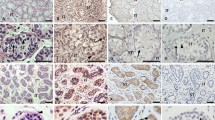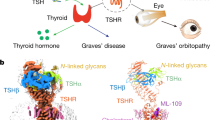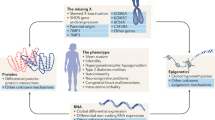Abstract
Anti–Müllerian hormone (AMH) and its receptor are involved in the regression of Müllerian ducts in male fetuses. We have now cloned and mapped the human AMH receptor gene and provide genetic proof that it is required for AMH signalling, by identifying a mutation in the AMH receptor in a patient with persistent Müllerian duct syndrome. The mutation destroys the invariant dinucleotide at the 5′ end of the second intron, generating two abnormal mRNAs, one missing the second exon, required for ligand binding, and the other incorporating the first 12 bases of the second intron. The similar phenotypes observed in AMH–deficient and AMH receptor–deficient individuals indicate that the AMH signalling machinery is remarkably simple, consisting of one ligand and one type II receptor.
This is a preview of subscription content, access via your institution
Access options
Subscribe to this journal
Receive 12 print issues and online access
$209.00 per year
only $17.42 per issue
Buy this article
- Purchase on Springer Link
- Instant access to full article PDF
Prices may be subject to local taxes which are calculated during checkout
Similar content being viewed by others
References
Jost, A. Problems of fetal endocrinology: the gonadal and hypophyseal hormones. Recent Prog. Horm. Res. 8, 379–418 (1953).
Imbeaud, S., Carré-Eusèbe, D., Rey, R., Belville, C., Josso, N. & Picard, J.Y. Molecular genetics of the persistent Müllerian duct syndrome: a study of 19 families. Hum. molec. Genet. 3, 125–131 (1994).
Baarends, W.M. et al. A novel member of the transmembrane serine/threonine kinase receptor family is specifically expressed in the gonads and in mesenchymal cells adjacent to the müllerian duct. Development 120, 189–197 (1994).
di Clemente, N. et al. Cloning, expression and alternative splicing of the receptor for anti-Müllerian hormone. Molec. Endocrinol. 8, 1006–1020 (1994).
Massagué, J. Receptors for the TGF-βfamily Cell 69, 1067–1070 (1992).
sanger, F., Nicklen, S. & Coulson, A.R. DNA sequencing with chain-terminating inhibitors. Proc. natn. Acad. Sci. U.S.A. 74, 5463–5467 (1977).
Kariya, Y., Kato, K., Hayashizaki, Y., Himeno, S., Tarui, S. & Matsubara, K. Revision of consensus sequence of human Alu repeats. Gene 53, 1–10 (1987).
Matzuk, M.M. & Bradley, A. Structure of the mouse activin receptor type II gene. Biochem. biophys. Res. Commun. 185, 404–413 (1992).
Humphries, D.E., Bloom, B.B., Fine, A. & Goldstein, R.H. Structure and expression of the promoter for the human type II transforming growth factor-β receptor. Biochem. biophys. Res. Commun. 203, 1020–1027 (1994).
Shen, W.H., Moore, C.C.D., Ikeda, Y., Parker, K.L. & Ingraham, H.A. Nuclear receptor steroidogenic factor 1 regulates the mullerian inhibiting substance gene: A link to the sex determination cascade. Cell 77, 651–661 (1994).
Harley, V.R., Lovell-Badge, R. & Goodfellow, P.N. Definition of a consensus DNA binding site for SRY. Nucl. Acids Res. 22, 1500–1501 (1994).
Wrana, J.L. et al. Two transmembrane serine/threonine kinases from Drosophila melanogaster form an activin receptor complex. Molec. cell. Biol. 14, 944–950 (1994).
Gustafson, M.L. et al. Müllerian inhibiting substance as a marker for ovarian sex-cord tumor. New Engl. J. Med. 326, 466–471 (1992).
Guerrier, D. et al. The persistent Müerian duct syndrome: a molecular approach. J. clin. Endocrinol. Metab. 68, 46–52 (1989).
Behringer, R.R., Finegold, M.J. & Cate, R.L. Müllerian-inhibiting substance function during mammalian sexual development. Cell 79, 415–425 (1994).
di Clemente, N. et al. Inhibitory effect of AMH upon the expression of aromatase and LH receptors by cultured granulosa cells of rat and porcine immature ovaries. Endocrine 2, 553–558 (1994).
Josso, N. et al. 1993 Anti-Müllerian hormone, the Jost factor. Recent Prog. Horm. Res. 48, 1–59 (1993).
Attisano, L., Wrana, J.L., Cheifetz, S. & Massagué, J. Novel activin receptors: distinct genes and alternative messenger RNA splicing generate a repertoire of serine/threonine kinase receptors. Cell 68, 97–108 (1992).
Koenig, B.B. et al. Characterization and cloning of a receptor for BMP-2 and BMP-4 from NIH 3T3 cells. Molec. cell. Biol. 14, 5961–5974 (1994).
Lin, H.Y., Wang, X.F., Ngeaton, E., Weinberg, R.A. & Lodish, H.F. Expression cloning of the TGF-β type II receptor, a functional transmembrane serine/threonine kinase. Cell 68, 775–785 (1992).
Wilson, C.A. et al. Müllerian inhibiting substance requires its N-terminal domain for maintenance of biological activity, a novel finding within the TGF-β superfamily. Molec. Endocrinol. 7, 247–257 (1993).
Krawczak, M., Reiss, J. & Cooper, D.N. The mutational spectrum of single base-pair substitutions in messenger RNA splice junctions of human genes - causes and consequences. Hum. Genet. 90, 41–54 (1992).
Talerico, M. & Berget, S.M. Effect of 5′ splice mutations on splicing of the preceding intron. Molec. cell. Biol. 10, 6299–6305 (1990).
Parkinson, D.B. & Thakker, R.V. A donor splice site mutation in the parathyroid hormone gene is associated with autosomal recessive hypoparathyroidism. Nature Genet. 1, 149–152 (1992).
Stover, M.L., Primorac, D., Liu, S.C., McKinstry, M.B. & Rowe, D.W. Defective splicing of messenger RNA from one COL1A1 allele of type-I collagen in nondeforming (type-I) osteogenesis imperfecta. J. clin. Invest. 92, 1994–2002 (1993).
Treisman, R., Proudfoot, N.J., Shander, M. & Maniatis, T. A single-base change at a splice site in a β0-thalassemic gene causes abnormal RNA splicing. Cell 29, 903–911 (1982).
Harada, N. et al. Biochemical and molecular genetic analyses on placental aromatase (pP-450AROM) deficiency. J. biol. Chem. 267, 4781–4785 (1992).
Yen, P.M. & Chin, W.W. Minireview: Molecular mechanisms of dominant negative activity by nuclear hormone receptors. Molec. Endocrinol. 8, 1450–1454 (1994).
Brand, T. & Schneider, M.D. Inactive type II and type I receptors for TGF-β are dominant inhibitors of TGF-β-dependent transcription. J. biol. Chem. 270, 8274–8284 (1995).
Cárcamo, J., Zentella, A. & Massagué, J. Disruption of transforming growth factor-β signaling by a mutation that prevents transphosphorylation within the receptor complex. Molec. cell. Biol. 15, 1573–1581 (1995).
Hemmati-Brivanlou, A. & Melton, D.A. A truncated activin receptor inhibits mesoderm induction and formation of axial structures in Xenopus embryos. Nature 359, 609–614 (1992).
Suzuki, A. et al. A truncated bone morphogenetic protein receptor affects dorsal-ventral patterning in the early Xenopus embryo. Proc. natn. Acad. Sci. U.S.A. 91, 10255–10259 (1994).
Matzuk, M.M., Kumar, T.R. & Bradley, A. Different phenotypes for mice deficient in either activins or activin receptor type II. Nature 374, 356–360 (1995).
Picon, R. Action du testicule foetal sur le développement in vitro des canaux de Müller chez le rat. Archs. Anat. microsc. Morphol. Exp. 58, 1–19 (1969).
Carré-Eusèbe, D., Imbeaud, S., Harbison, M., New, M.I., Josso, N. & Picard, J.Y. Variants of the anti-Müllerian hormone gene in a compound heterozygote with the persistent Müllerian duct syndrome and his family. Hum. Genet. 90, 389–394 (1992).
Chirgwin, J.M., Przybyla, A.E., MacDonald, R.J. & Rutter, W.J. Isolation of biologically active ribonucleic acid from sources enriched in ribonuclease. Biochemistry 18, 5294–5299 (1979).
Glisin, V., Crkvenjakov, R. & Byus, C. Ribonucleic acid isolated by cesium chloride centrifugation. Biochemistry 13, 2633–2637 (1974).
Benton, W.D. & Davis, R.W. Screening lambda gt recombinant clones by hybridization to single plaques in situ. Science 196, 180–182 (1977).
Sambrook, J., Fritsch, E.F. & Maniatis, T. Molecular Cloning: a Laboratory Manual. (Cold Spring Harbor Laboratory Press, Cold Spring Harbor, 1989).
Burke, J.F. High sensitivity S1 mapping with single-stranded (32P)DNA probes synthesized from bacteriophage M13 mp templates. Gene 30, 63–68 (1984).
Barsoum, J. Introduction of stable high-copy number DNA into Chinese hamster ovary cells by electroporation. DNA 9, 293–300 (1990).
Pepinsky, R.B. et al. Proteolytic processing of Müllerian inhibiting substance produces a transforming growth factor-β-ike fragment. J. biol. Chem. 263, 18961–18965 (1988).
Lottenberg, R., Christensen, C.M., Jackson, P.L. & Coleman, P.L. Assay of coagulation proteases using peptide chromogenic and fluorogenic substrates. Methods Enzymol. 80, 341–361 (1981).
di Clemente, N. et al. A quantitative and interspecific test for biological activity of anti-Müllerian hormone: the fetal ovary aromatase assay. Development 114, 721–727 (1992).
Redinbaugh, M.G. & Turley, R.B. Adaptation of the bicinchoninic acid protein assay for use with microtiter plates and sucrose gradient fractions. Analyt. Biochem. 153, 267–271 (1986).
Knebelmann, B. et al. Anti-Müllerian hormone Bruxelles: a nonsense mutation associated with the persistent Müllerian duct syndrome. Proc. natn. Acad. Sci. U.S.A. 88, 3767–3771 (1991).
Orita, M., Suzuki, Y., Sekiya, T. & Hayashi, K. Rapid and sensitive detection of point mutations and DNA polymorphisms using the polymerase chain reaction. Genomics 5, 874–879 (1989).
Myers, R.M., Tilly, K. & Maniatis, T. Fine structure genetic analysis of a β-globin promoter. Science 232, 613–618 (1986).
Wall, L., deBoer, E. & Grosveld, F. The human β-globin gene 3′ enhancer contains multiple binding sites for an erythroid-specific protein. Genes Dev. 2, 1089–1100 (1988).
Author information
Authors and Affiliations
Rights and permissions
About this article
Cite this article
Imbeaud, S., Faure, E., Lamarre, I. et al. Insensitivity to anti–Müllerian hormone due to a mutation in the human anti–Müllerian hormone receptor. Nat Genet 11, 382–388 (1995). https://doi.org/10.1038/ng1295-382
Received:
Accepted:
Issue Date:
DOI: https://doi.org/10.1038/ng1295-382
This article is cited by
-
Identification of four novel variant in the AMHR2 gene in six unrelated Turkish families
Journal of Endocrinological Investigation (2021)
-
Müller-Gang-Persistenzsyndrom mit synchronem Keimzelltumor in einem jungen Erwachsenen
Journal für Urologie und Urogynäkologie/Österreich (2020)
-
Next-generation sequencing reveals genetic landscape in 46, XY disorders of sexual development patients with variable phenotypes
Human Genetics (2018)
-
Isolation of anti-MISIIR scFv molecules from a phage display library by cell sorter biopanning
Cancer Immunology, Immunotherapy (2008)



